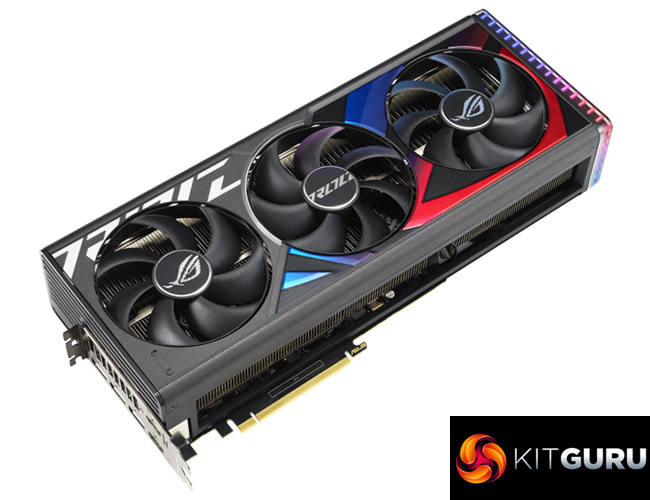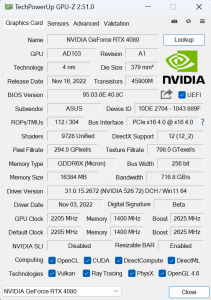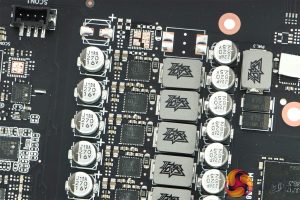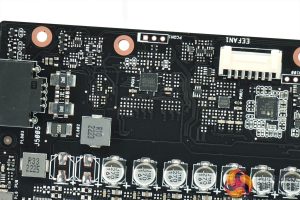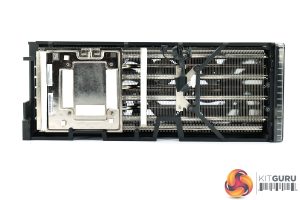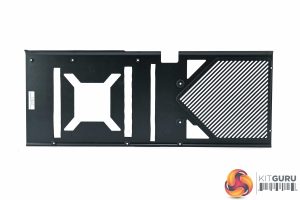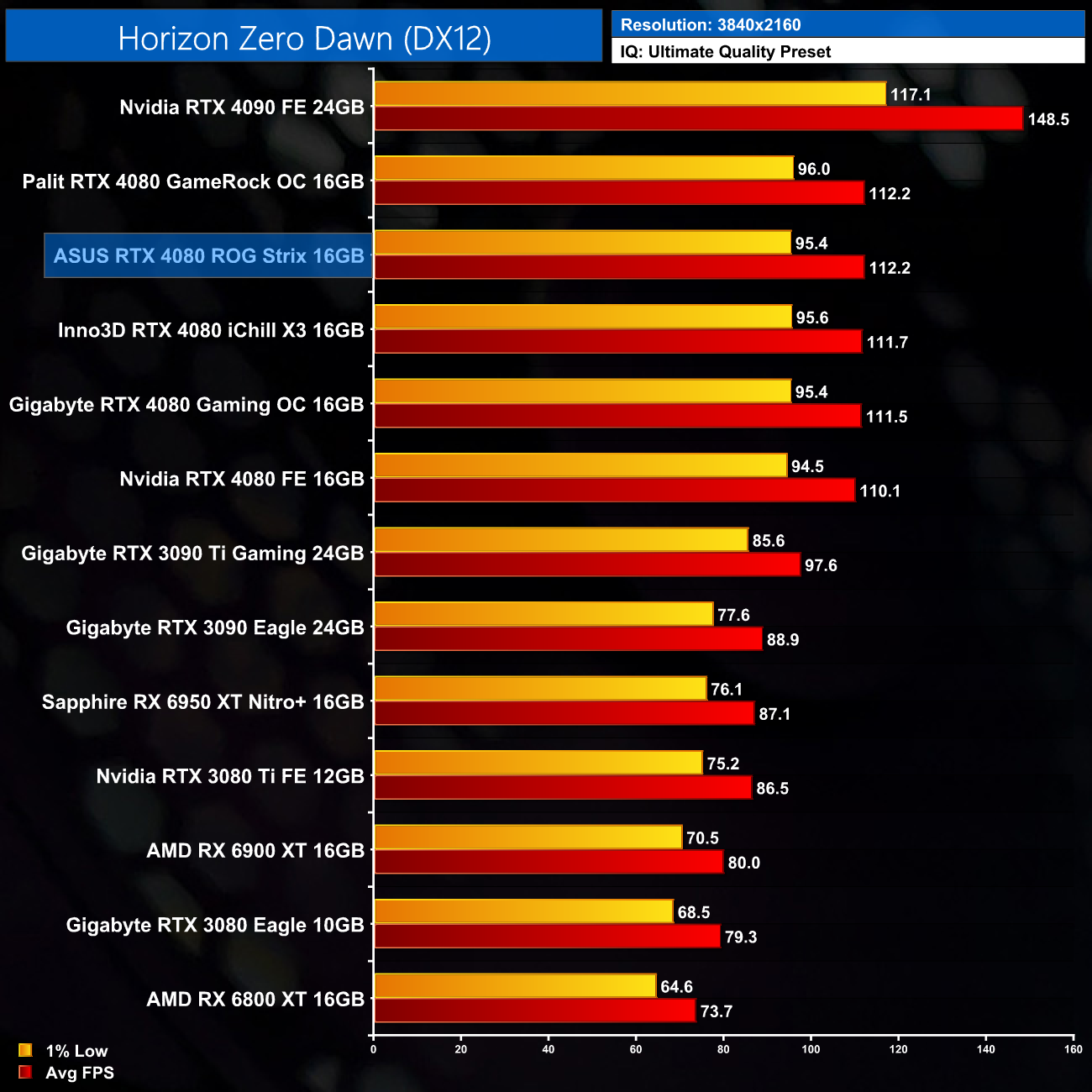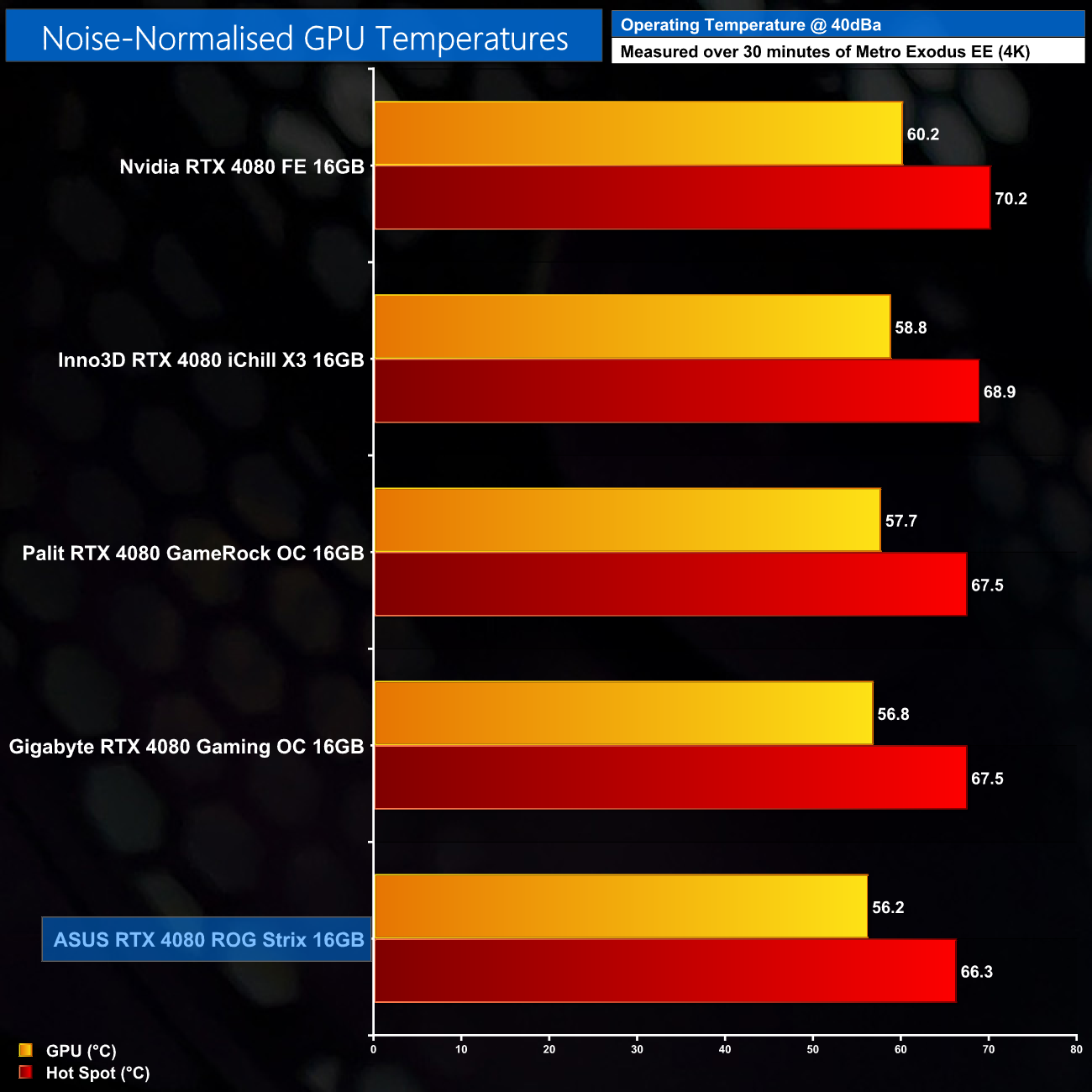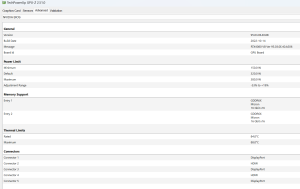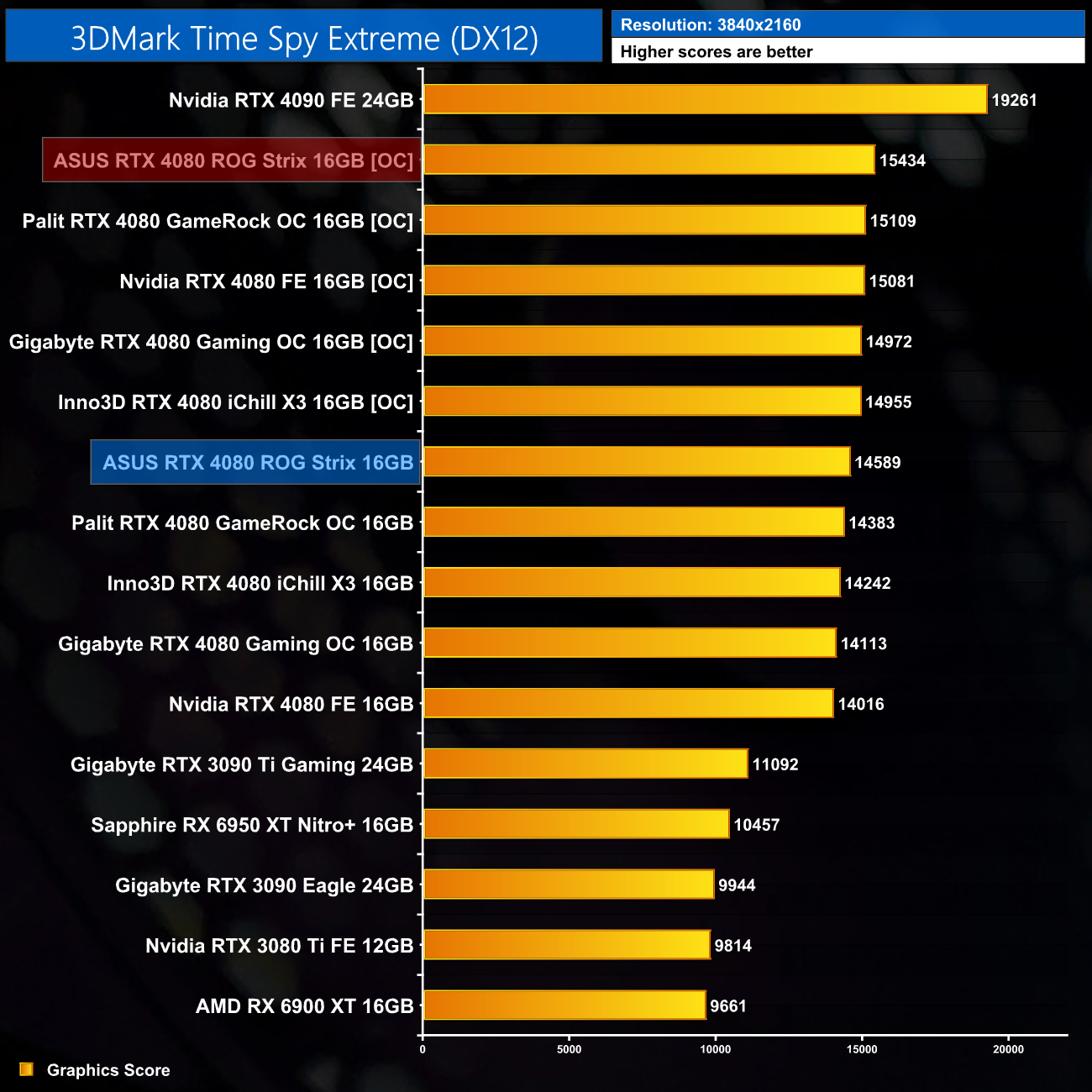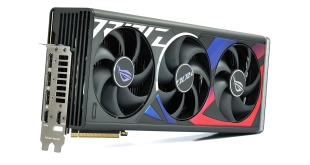
We're almost ready to see what AMD can bring to the market with its RDNA 3-based GPUs, but first we have one more RTX 4080 partner card to assess. This time we're looking at ASUS' flagship, the RTX 4080 ROG Strix. It's a physically huge card that packs a ton of features, including a heavily overclocked core, dual-BIOS, and even a pair PWM fan headers on the card itself. How will it stack up against the competition? We find out today.
The ASUS RTX 4080 ROG Strix is an extreme card in almost every sense of the word. Not only is it absolutely massive, measuring over 35cm long, but it also sports an eye-catching shroud design, with blue and red accents on the front of the card. Factor in the RGB lighting, all-metal shroud and backplate, aggressive overclock and the highest power limit of any RTX 4080 we've tested so far, and there is certainly a lot of promise here.
Let's find out if this card can deliver…
| RTX 4090 | RTX 4080 | RTX 3090 Ti | RTX 3090 | RTX 3080 Ti | RTX 3080 | |
| Process | TSMC N4 | TSMC N4 | Samsung 8N | Samsung 8N | Samsung 8N | Samsung 8N |
| SMs | 128 | 76 | 84 | 82 | 80 | 68 |
| CUDA Cores | 16384 | 9728 | 10752 | 10496 | 10240 | 8704 |
| Tensor Cores | 512 | 304 | 336 | 328 | 320 | 272 |
| RT Cores | 128 | 76 | 84 | 82 | 80 | 68 |
| Texture Units | 512 | 304 | 336 | 328 | 320 | 272 |
| ROPs | 176 | 112 | 112 | 112 | 112 | 96 |
| GPU Boost Clock | 2520 MHz | 2505 MHz | 1860 MHz | 1695 MHz | 1665 MHz | 1710 MHz |
| Memory Data Rate | 21 Gbps | 22.4 Gbps | 21 Gbps | 19.5 Gbps | 19 Gbps | 19 Gbps |
| L2 Cache | 73728 KB | 65536 KB | 6144 KB | 6144 KB | 6144 KB | 5120 KB |
| Total Video Memory | 24GB GDDR6X | 16GB GDDR6X | 24GB GDDR6X | 24GB GDDR6X | 12GB GDDR6X | 10GB GDDR6X |
| Memory Interface | 384-bit | 256-bit | 384-bit | 384-bit | 384-bit | 320-bit |
| Memory Bandwidth | 1008 GB/Sec | 716.8 GB/Sec | 1008 GB/Sec | 936 GB/Sec | 912 GB/Sec | 760 GB/Sec |
| TGP | 450W | 320W | 450W | 350W | 350W | 320W |
Above: Performance BIOS, left, Quiet BIOS, right.
First, for a quick spec recap. RTX 4080 uses the AD103 die, and this is notably smaller than AD102, measuring 378.6mm2. Accordingly, transistor count is reduced from 76.3 billion, down to 45.9 billion. The fundamental building blocks are still the same of course, with the RTX 4080 offering a total of 84 Streaming Multiprocessors (SMs), each housing 128 CUDA Cores, for a total of 9728. We also find 84 RT cores, 336 Tensor cores, 336 Texture Units, and 112 ROPs.
TSMC's N4 node has Nvidia cranking up the clock speed significantly this generation, with the RTX 4080 sporting a 2505MHz rated boost clock. ASUS has increased this further with a 120MHz factory overclock that applies whether you are using the Performance or Quiet BIOS.
The memory configuration is another area where AD103 has been cut-back significantly. The memory interface has been reduced to 256-bit, and even with 16GB GDDR6X running at 22.4Gbps, that cuts memory bandwidth down to 716.6GB/s. That said, there has been a substantial upgrade to the L2 cache with the Ada architecture, with the RTX 4080 now offering 65.5MB, compared to just 6MB for GA102.
Considering RTX 4080 is notably cut-down versus the RTX 4090, rated power draw is lower, with a 320W TGP. ASUS has increased this to 360W for the Performance BIOS but the Silent BIOS keeps the 320W limit.
The ASUS RTX 4080 ROG Strix ships in a generally dark box, but with the signature ROG red and blue colours visible on the front, along with an image of the card itself. On the back, ASUS highlights various key features of the dark and cooler design.
Inside we find various pieces of documentation, including a quick start guide and warranty note. ASUS also includes a branded velcro strap and a triple 8-pin power adapter. We get another GPU support bar, identical to the one we saw with the ASUS TUF RTX 4090 last month. This is height adjustable and simply helps prop up the graphics card to prevent sag. It's simple and works well, though I would have liked to see it painted black with the ROG Strix – the grey colourway works perfectly for the TUF Gaming card, but stands out a little too much when used with the Strix in my opinion.
As for the card itself, ASUS has been quite bold with the overall design. The shroud is mostly black, but the red and blue accents are unmissable, taking the shape of the ROG eye logo. It may not be to everyone's tastes, though do remember you are unlikely to actually be able to see these colours unless you vertically mount the card.
We have to hand it to ASUS for the build quality of the card though – it is extremely solid and premium-feeling in the hand. ASUS is using a metal shroud here, reinforced by a die-cast internal metal frame, while the backplate is also made of metal as we shall see below. It does add weight, but this has to be the most solid-feeling graphics card that I can remember.
We can note the three Axial-tech fans too, each measuring 100mm. ASUS claims this new larger design provides 23% better airflow than the previous generation.
We do also get a look at the RGB above – in the form of the Republic of Gamers branding, and also with a rectangular strip on the end of the card. Out of the box, the colouring matches the blue and red theme, but this can be adjusted using ASUS Armoury Crate.
We do have to mention the sheer size of this card however – it is the biggest I have ever tested, measuring in at 357.6 x 149.3 x 70.1mm. It's also very heavy, weighing 2.404kg on my scales.
The front side of the card is home to the GeForce RTX branding, printed in white text, as well as the Republic of Gamers tag which is one of the RGB zones (as shown above).
Flipping over to the backplate, this is another eye-catching design. It is made from metal and features a large, reflective ROG logo that uses a mirror finish. The end of the backplate is perforated to allow air to flow through the heatsink, but is still home to another ROG eye logo finished in silver, contrasting with the black metal.
The very end of the card is home to two 4-pin fan headers as well. This is a feature ASUS has included for years and is a great way to add two fans to the system, with the fan curve based on the GPU's temperature.
We can also note the 12VHPWR connector, and then a total of five display outputs. ASUS did the same with the TUF 4090, but essentially we have three DisplayPort 1.4 and two HDMI 2.1 connectors – only four can be used at once, but it's great to have the added HDMI 2.1 port for extra flexibility.
As for the PCB, it does appear to be a broadly similar design to the TUF Gaming RTX 4090, but with a few tweaks. For one, ASUS is using an eighteen-phase VRM for the GPU, and a three-phrase VRM for the memory.70A Infineon TDA21570 MOSFETs are used for GPU VRM power delivery, though ASUS switches these for 50A Vishay SIC639 MOSFETs for the memory.
A Monolithic Power Systems MP2888A controller is used for the GPU VRM, with a UPI UP9529Q controlling the memory VRM.
For the cooler, ASUS is using a large vapour chamber that contacts both the GHPU die and memory modules, via thermal pads. This sits on a total of seven heatpipes, utilising a huge finstack for heat dissipation. ASUS is also using thermal pads on the underside of the backplate, contacting the rear of the PCB.
Driver Notes
- All AMD GPUs were benchmarked with the Adrenalin 22.10.3 driver.
- All Nvidia GPUs (except RTX 4080) were benchmarked with the 526.61 driver.
- RTX 4080 was benchmarked with the 527.72 driver supplied to press.
Benchmark results are only comparable where this exact configuration has been used.
Test System:
We test using a custom built system powered by MSI, based on Intel’s Alder Lake platform. You can read more about this system HERE and check out MSI on the CCL webstore HERE.
| CPU |
Intel Core i9-12900K
|
| Motherboard |
MSI MEG Z690 Unify
|
| Memory |
32GB (2x16GB) ADATA XPG Lancer DDR5 6000MHz
CL 40-40-40
|
| Graphics Card |
Varies
|
| SSD |
2TB MSI Spatium M480
|
| Chassis | MSI MPG Velox 100P Airflow |
| CPU Cooler |
MSI MEG CoreLiquid S360
|
| Power Supply |
Corsair 1200W HX Series Modular 80 Plus Platinum
|
| Operating System |
Windows 11 Pro 21H2
|
| Monitor |
MSI Optix MPG321UR-QD
|
| Resizable BAR |
Enabled for all supported GPUs
|
Comparison Graphics Cards List
- Sapphire RX 6950 XT Nitro+ 16GB
- AMD RX 6900 XT 16GB
- AMD RX 6800 XT 16GB
- Nvidia RTX 4090 Founders Edition 24GB
- Nvidia RTX 4080 Founders Edition 16GB
- Gigabyte RTX 4080 Gaming OC 16GB
- Inno3D RTX 4080 iChill X3 16GB
- Palit RTX 4080 GameRock OC 16GB
- Gigabyte RTX 3090 Ti Gaming 24GB
- Gigabyte RTX 3090 Eagle 24GB
- Nvidia RTX 3080 Ti Founders Edition 12GB
- Gigabyte RTX 3080 Eagle 10GB
All cards (except RTX 4080 AIB models) were tested at reference specifications.
Software and Games List
- 3DMark Fire Strike & Fire Strike Ultra (DX11 Synthetic)
- 3DMark Time Spy (DX12 Synthetic)
- 3DMark DirectX Raytracing feature test (DXR Synthetic)
- Assassin's Creed Valhalla (DX12)
- Cyberpunk 2077 (DX12)
- Days Gone (DX11)
- Dying Light 2 (DX12)
- Far Cry 6 (DX12)
- Forza Horizon 5 (DX12)
- God of War (DX11)
- Horizon Zero Dawn (DX12)
- Marvel's Spider-Man Remastered (DX12)
- Metro Exodus Enhanced Edition (DXR)
- Red Dead Redemption 2 (DX12)
- Resident Evil Village (DX12)
- Total War: Warhammer III (DX11)
We run each benchmark/game three times, and present mean averages in our graphs. We use FrameView to measure average frame rates as well as 1% low values across our three runs.
3DMark Time Spy is a DirectX 12 benchmark test for Windows 10 gaming PCs. Time Spy is one of the first DirectX 12 apps to be built the right way from the ground up to fully realize the performance gains that the new API offers. With its pure DirectX 12 engine, which supports new API features like asynchronous compute, explicit multi-adapter, and multi-threading, Time Spy is the ideal test for benchmarking the latest graphics cards. (UL).
Early performance indicators from 3DMark Time Spy Extreme are positive – the ROG Strix scores just shy of 14600 points, making it the top-scoring RTX 4080 we have tested so far.
Here we test five games, all at 3840×2160 resolution using maximum image quality settings.
Over the five titles we tested, ASUS' ROG Strix RTX 4080 proves the fastest-running RTX 4080. Not always by much, as it ran 2-4% faster than Nvidia's Founders Edition, so we're talking a difference of 5FPS at most (in Resident Evil Village). We always say that a factory overclock should not be a key consideration when purchasing a new graphics card, as you are highly unlikely to be able to tell the difference when gaming.
Here we present the average clock speed for each graphics card while running Metro Exodus Enhanced Edition for 30 minutes. We use GPU-Z to record the GPU core frequency during gameplay. We calculate the average core frequency during the 30-minute run to present here.
The reason the Strix proved to be the fastest-running RTX 4080 yet is as a result of its high operating clock speed. With a rated clock speed of 2625MHz, it boosted well over 2800MHz during our testing – in fact, averaged over our thirty minute stress test, it operated at 2862MHz. That's about 140MHz faster than the Founders Edition, and 40MHz faster than its next-closed rival, the Palit GameRock OC.
For our temperature testing, we measure the peak GPU core temperature under load. A reading under load comes from running Metro Exodus Enhanced Edition for 30 minutes.
Thermals are an impressive area for the ROG Strix. Both BIOS modes saw the GPU operate around the 60C mark, with the hot spot hovering below 70C. Both are excellent results, and although not the outright best, do remember that these are out of the box results – in other words, they don't take fan speed (therefore noise levels) into account.
You may also be wondering why both Performance and Quiet BIOS results are so similar. While the Quiet BIOS does run a significantly slower fan speed, it also has a lower power limit of 320W, compared to 360W for the Performance BIOS. It seems the lower power but lower fan speed of the Quiet BIOS is roughly matched by the higher power but higher fan speed of the Performance BIOS.
For our temperature testing, we measure the peak memory temperature under load. A reading under load comes from running Metro Exodus Enhanced Edition for 30 minutes.
The same can be said for the memory thermals, with both BIOS modes producing a peak temperature of 66C. This is good enough, though perhaps not jaw-droppingly good – but then again, there's no practical benefit to the GDDR6X to run any cooler, so it almost doesn't matter.
We take our noise measurements with the sound meter positioned 1 foot from the graphics card. I measured the noise floor to be 32 dBA, thus anything above this level can be attributed to the graphics cards. The power supply is passive for the entire power output range we tested all graphics cards in, while all CPU and system fans were disabled. A reading under load comes from running Metro Exodus Enhanced Edition for 30 minutes.
Overall noise output of the ASUS RTX 4080 ROG Strix is very low indeed. The Performance BIOS is already very quiet, with the fans running at 37%, or just 1210rpm. The Quiet mode improves on this further, dropping fan speed to 31%, or 1030rpm. This resulted in a noise level of 32 dBa – the noise floor of my office. In other words, from a distance of 30cm you couldn't hear a difference between the fans spinning or not, it is that quiet!
My sample did exhibit a small amount of coil whine, though nothing major whatsoever and it was barely audible over my chassis fans. This can depend on the specific PSU as well, so that's another thing to bear in mind.
Following on from our stock thermal and acoustic testing, here we re-test the operating temperature of the GPU, but with noise levels normalised to 40dBa. This allows us to measure the efficiency of the overall cooling solution as varying noise levels as a result of more aggressive fan curves are no longer a factor.
Considering the Strix is so quiet, we had to increase fan speed up to 54%, or 1720rpm, to hit 40dBa of noise. That resulted in best-in-class GPU thermals, which is even more impressive when you consider that it also has the highest power limit of any other RTX 4080 we have tested, at 360W (most others are 340W or 320W.)
Memory thermals also dropped, this time to 60C, which is still a 6C improvement over the Founders Edition, even if other competitors offer better results.
We use Nvidia PCAT to measure power draw of the graphics card only, with readings from both the PCIe slot and the PCIe power cables combined into a single figure. We use Resident Evil Village (4K) for this testing.
Power draw is the highest of any RTX 4080 we've tested, but only by 4W – it hit 329W in Resident Evil Village, still a good deal below its rated 360W TGP.
For our manual overclocking tests, we used MSI Afterburner. Our best results are as below.
Above: Performance BIOS, left, Quiet BIOS, right.
When overclocking, it's important to note that both BIOS modes have different power limits, which may affect the maximum overclock you are able to achieve. The Performance BIOS has a 360W limit out of the box than can be increased to 420W (+17%). The Quiet BIOS, meanwhile, has a 320W power limit out of the box that can be increased to 380W (+19%).
We used the Performance BIOS for our overclocking, and were able to add 160MHz to the GPU and 1400MHz to the memory.
This saw the average operating clock speed increase to over 3GHz – the first RTX 4080 I have been able to achieve that with.
Actual performance increases as a result of this overclock varied between 5-7%, which is in line with what we have come to expect.
Power draw rose by 16W as a result of this overclock, an increase of just 5%.
As the fifth RTX 4080 that I have now reviewed, there is no doubt in my mind that the ASUS RTX 4080 ROG Strix is the best of the lot – and by a fair distance.
Things got off to a good start as the Strix is incredibly well built, with a metal shroud, backplate and inner frame, all of which gives it a highly premium look and feel. Admittedly, the choice of the blue and red accent colours on the shroud may not be for everyone, but unless you are vertically mounting the graphics card, you wouldn't see them anyway, so I don't think it matters too much.
Cooling performance is a very strong area for the Strix as well – when noise-normalised, we saw the best GPU thermals we have seen from any RTX 4080 so far, though the margins are fairly slim. Arguably more impressive is the low noise output from the card however, particularly if you opt for the Quiet BIOS. This drops fan speed to barely 1000rpm, resulting in a whisper-quiet graphics card.
The dual-BIOS implementation is also very good as a whole, with a choice between the higher power but higher fan speed Performance BIOS, or the lower power but lower fan speed Quiet BIOS. ASUS also included two 4-pin PWM fan headers on the end of the card which is a nice value add if you want to add in a couple of extra case fans that are controlled from the GPU.
All told, I look at the overall design and engineering that went into the Strix and it is hard to come away feeling anything other than highly impressed. However… at the end of the day, this is still an RTX 4080 GPU, using Nvidia's AD103 silicon. As good as the card and cooler that ASUS built are, that doesn't change the fact you are still getting a GPU that simply does not offer good value.
Unfortunately, that is compounded by the fact that the Strix is currently the joint-most expensive RTX 4080 at Overclockers UK, coming in at £1469.99. That's a 22% increase over Nvidia's baseline MSRP, and is just way too close to the asking price of the RTX 4090 – something that just makes very little sense to me. Would you really drop almost £1500 on a graphics card, but not stump up the extra 100 or-so Pounds to get the best of the best?
Because of that, I look at the ASUS RTX 4080 ROG Strix as somewhat of a ‘tech demo', a demonstration of what ASUS can do and what a brilliant graphics card can be like, but ultimately something that isn't a realistic purchase for the vast, vast majority of gamers out there.
We found the RTX 4080 ROG Strix for £1469.99 on Overclockers UK HERE.
Pros
- Incredibly well built.
- Best noise-normalised GPU thermals of any RTX 4080 so far.
- Fasted RTX 4080 we've tested.
- Quietest RTX 4080 yet.
- Excellent dual-BIOS implementation.
- Extra two PWN fan headers on the card.
Cons
- RTX 4080 is poor value overall.
- Very steep price premium over the baseline MSRP puts the price far too close to the RTX 4090.
- Largest card we've ever tested.
KitGuru says: It's the fastest, coolest and quietest – but the pricing is exorbitant for an RTX 4080.
 KitGuru KitGuru.net – Tech News | Hardware News | Hardware Reviews | IOS | Mobile | Gaming | Graphics Cards
KitGuru KitGuru.net – Tech News | Hardware News | Hardware Reviews | IOS | Mobile | Gaming | Graphics Cards


